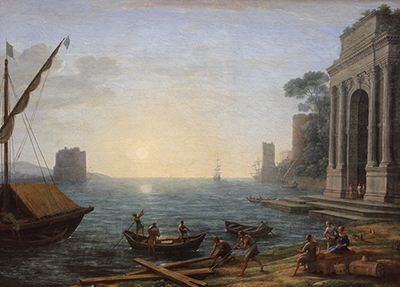A Seaport at Sunrise is a 1674 artwork by Claude Lorrain, making it one of the final paintings to come from his illustrious career. It was relatively small by his standards, measuring 96cm wide by 72cm tall.
The painting is a typical Claude Lorrain seascape, featuring elements of classical architecture to the sides of the composition, whilst leading out into an open expanse of relatively calm waters. A bright sun sits at the very back, hanging relatively low which allows the light to reflect across the tops of the waves. A few light clouds are added, but the sky is bright and relatively plain, without the need for an emotional mood to strike through. There is a relaxing mood within most of the artist's paintings, be it landscapes or seascapes, and this approach would be replaced by more dramatic depictions by other artists in this century. We find a busy harbour side in the foreground, with many figures dotted about. There is a section of a tall ship to the left hand side but this composition is relatively open and offers a reduced amount of detail as compared to the more intense, Seaport with the Embarkation of Saint Ursula/, for example. Whilst his output was extremely consistent, Lorraine did vary his compositions slightly as his career developed, with this piece arriving very late in his overall oeuvre.
The artist is known to have produced three different interpretations of a seaport at sunrise, all with slightly different titles in order to allow them to be differentiated. He would record his new work within a book which also featured drawings of some of them. This has helped historians to more accurately account for his life's work, although many of his earlier creations were not included. Sunrises and sunsets became more common within landscape painting because of the influence of Claude who would use these themes several times himself. Others quickly realised the opportunities that these times of the day brought to an artwork in terms of light, which could impact everything else within each scene. Later movements would evolve his findings and take things onwards once more, helping landscape art to become the much loved genre that it is today. Some have argued that the artist's legacy was greater than the excitement and energy found within his own paintings, though most accept that Claude's technical mastery of landscape art was something to truly behold.
This painting can today be found in the permanent collection of the Alte Pinakothek in Munich, Germany. This important art venue hosts an exceptional selection of paintings and drawings from the old masters, with most major movements covered, dating back to the early Renaissance. Besides the inclusion of Claude, other artists to look out for include include the likes of Leonardo da Vinci's (Madonna of the Carnation), Rembrandt van Rijn (The Descent from the Cross, The Holy Family), Domenico Ghirlandaio (Virgin and Child with SS. Dominici, Michael, John the Baptist and John the Evangelist) and also Lorenzo Lotto (The Mystic Marriage of St. Catherine). Italian, French, German and Flemish art is particularly well served here, marking the considerable impact that both of these regions have made at different points over the past seven centuries or so.




